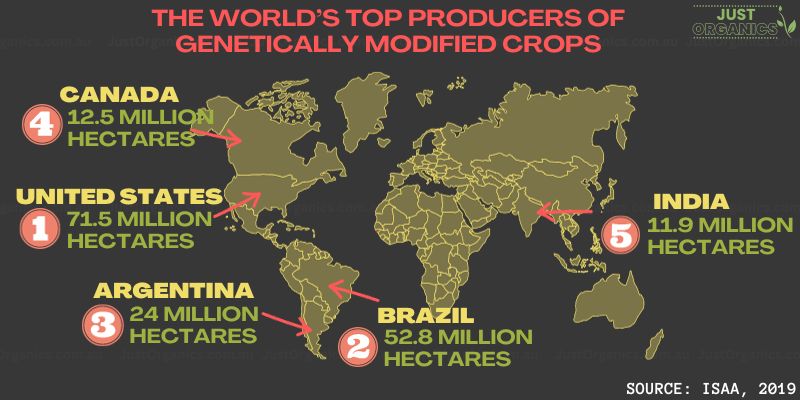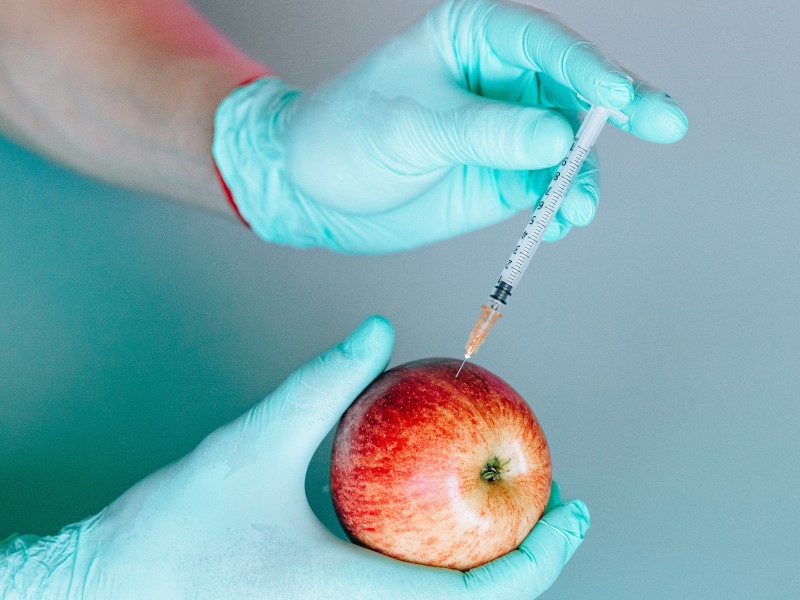Are GMOs a boon or a bane? Genetically Modified Organisms (GMOs) have sparked heated discussions, with supporters highlighting their potential benefits and opponents raising concerns about their risks. By manipulating the DNA of organisms, particularly in agriculture, GMOs can offer advantages like improved nutrition, reduced pesticide use, and lower costs. However, worries linger regarding health effects and the impact on the environment.
This article aims to provide an objective analysis of the pros and cons of GMOs, shedding light on their impact on our food system and environment. After reading this, you’ll hopefully have a better idea of the pros and cons of genetically modified organisms and whether they are something you’ll ignore or avoid.
Key Takeaways
- GMOs offer benefits such as increased nutritional value, reduced pesticide use, and lower food prices.
- Health concerns about GMOs persist, such as triggering allergies and antibiotic resistance.
- The ongoing research and monitoring of GMOs contribute to their safety and effectiveness.
Table of Contents
What are GMOs?
GMOs, or genetically modified organisms, are created by altering an organism’s DNA using genetic engineering technology. This process allows scientists to insert specific genes into the DNA of plants or animals, giving them desired traits. In agriculture, these traits might make a food crop more disease-resistant, drought-tolerant, or grow faster.
As of 2019, there were 17 million farmers in 29 countries producing GMO crops, with the top five countries in terms of crop area being:
- United States
- Brazil
- Argentina
- Canada
- India

What is Being Produced?
In agriculture, there are a number of food crops producing the following:
| Crop | Common GMO Traits |
|---|---|
| Corn (Maize) | Insect resistance and herbicide tolerance |
| Soybeans | Herbicide tolerance and improved oil composition |
| Cotton | Insect resistance and herbicide tolerance |
| Canola (Rapeseed) | Herbicide tolerance |
| Sugar Beets | Herbicide tolerance |
| Alfalfa | Herbicide tolerance |
| Papaya | Disease resistance (ringspot virus) |
| Squash | Virus resistance |
| Potatoes | Reduced bruising and enhanced storage |
| Apples | Reduced browning |
10 Ways that GMOs are Used in Agriculture:
- Insect Resistance: Crops can be engineered to produce proteins toxic to specific insect pests and reduce the need for chemicals. For instance, crops like Bt cotton and Bt corn contain genes from the bacterium Bacillus thuringiensis, which produce proteins lethal to certain insects.
- Herbicide Tolerance: Some crops are designed to tolerate specific herbicides, allowing farmers to control weeds more effectively. For example, glyphosate-resistant crops (e.g., Roundup Ready soybeans and cotton) can withstand the application of weedkillers that include glyphosate.
- Disease Resistance: Genetic modifications can confer resistance to certain plant diseases. For instance, papaya plants have been genetically modified to resist the ringspot virus, saving the papaya industry in Hawaii.
- Drought Tolerance: GMO plants can be engineered to withstand drought conditions better. These crops can maintain higher yields during water scarcity, helping to ensure food production in regions prone to drought.
- Improved Nutritional Content: Some crops have been genetically modified to have enhanced nutritional profiles. For example, “Golden Rice” has been developed with increased beta-carotene (provitamin A) levels to address vitamin A deficiency in regions where rice is a dietary staple.
- Faster Maturation: Genetic modifications can shorten the time it takes for a crop to reach maturity. This can enable farmers to grow multiple crop cycles in a year, increasing overall yield.
- Resistance to Environmental Stress: GMOs can be made more resilient to various environmental stresses, such as cold temperatures, heat, and salinity, making them better suited for challenging growing conditions.
- Reduced Spoilage: Genetic modifications can extend the shelf life of certain crops by delaying the onset of ripening and reducing susceptibility to bruising and other forms of damage.
- Altered Nutrient Composition: Some GMOs are engineered to have specific nutrient compositions, such as oils with modified fatty acid profiles for improved nutritional value or industrial use.
- Improved Flavor and Quality: Genetic modifications can enhance the taste, texture, and overall quality of crops, making them more appealing to consumers.
GMOs are also used to produce medicines, vaccines, and enzymes, where genetic modification allows for the efficient production of these substances. Let’s look at how GMOs are used in the field of medicine.
Ways that GMOs are used in Medicine:
- Production of Medicines: GMOs, such as bacteria and yeast, can be engineered to produce therapeutic proteins and drugs. For example, insulin, human growth hormone, and vaccines like hepatitis B are produced using genetically modified organisms. This allows for more efficient and cost-effective production of these essential medicines.
- Research Tools: Genetically modified animals and cell lines are valuable tools for understanding the genetic basis of diseases. They are used to study the effects of specific genes and mutations, helping researchers uncover new insights into diseases and potential treatments.
- Vaccine Development: GMOs are crucial in vaccine production. For instance, some vaccines, like the hepatitis B vaccine mentioned earlier, are produced by genetically engineered yeast. GMOs are also used to develop vaccines for emerging diseases and pandemics, as they can be rapidly engineered to express viral antigens.
- Gene Therapy: In gene therapy, GMOs are used to deliver therapeutic genes into a patient’s cells to treat genetic disorders. Modified viruses and other vectors can be used to carry the desired genes into the body, providing a potential cure or treatment for various genetic diseases.
- Biopharmaceuticals: GMOs are used to produce biopharmaceuticals, which are complex proteins used to treat diseases like cancer and autoimmune disorders. These proteins can be challenging to produce without genetic modification.
- Drug Testing: Genetically modified cells and organisms are used in pre-clinical drug testing to evaluate the safety and efficacy of new medicines. They can help identify potential side effects and ensure that drugs are effective in their intended targets.
- Disease Modeling: Genetically engineered animals, like mice, are used to create models of human diseases. These models allow researchers to understand disease mechanisms better and test potential treatments before they are used in humans.
- Enhanced Drug Development: Genetic modification can accelerate drug discovery by allowing researchers to target specific cellular pathways involved in diseases. This precision can lead to the development of more effective and targeted therapies.
- Production of Diagnostic Tools: GMOs are used to create diagnostic tools and tests for various diseases, such as genetically engineered bacteria that change color in the presence of specific pathogens or biomarkers.
Pros of GMOs
Boost Crop Yields
GMOs, also known as genetically modified organisms, have proven to be a remarkable tool in modern agriculture. Their primary advantage lies in enhancing crop yields on existing farmlands. Let’s imagine a scenario where you have a fixed piece of land, and traditionally, you could only grow a certain amount of crops on it. However, with the introduction of GMOs, scientists have been able to modify specific genes within plants, resulting in significant improvements.
These modifications can make crops more resistant to pests, diseases, and environmental stresses like drought or extreme temperatures. By incorporating GMOs into farming practices, farmers can generate higher yields from the same land, ensuring a more efficient and sustainable use of resources.

Improve the Quality of Grown Food
One of the primary advantages of GMOs is their potential to enhance crop quality. With the ability to introduce desirable characteristics into plants, such as improved resistance to pests, diseases, and environmental stressors, GMOs can help farmers produce higher yields and more efficient crops. These modifications can also increase the nutritional value of certain foods, making them more beneficial to human health.
Using GMOs can reduce the reliance on chemicals to deal with pests and weeds. By incorporating genes that provide natural resistance to pests, farmers can use fewer chemical inputs, minimising potential harm to the environment and reducing their overall ecological footprint. This, in turn, promotes a more sustainable and environmentally friendly approach to farming.
It’s important to note that GMO crops undergo rigorous testing and evaluation by regulatory bodies to ensure their safety for consumption. Numerous scientific studies have been conducted to assess the potential risks associated with GMOs, and the consensus among reputable scientific organisations is that GMOs are safe to eat.
GMOs can potentially advance the quality of the food we grow significantly. By introducing beneficial traits, these modified organisms can enhance crop productivity, nutritional value, and sustainability.
GMO Crops May Have Fewer Pesticides
One notable advantage of genetically modified organisms is their ability to withstand pests and diseases, reducing pesticide use. By incorporating genes from other organisms, GMO crops can produce proteins that naturally repel pests, minimising the need for chemical treatments. This benefits the environment by reducing chemical runoff and promoting sustainable farming practices.
Additionally, fewer chemicals used in GMO crop cultivation can decrease health risks for farmers and consumers. Overall, the ability of GMO crops to require fewer pesticides presents a promising avenue for enhancing agricultural sustainability and reducing the impact on the environment of conventional farming methods.
Cons of GMOs
While GMOs offer many benefits, there are also concerns surrounding their use. One of the main concerns is the uncertainty of long-term safety effects. Although regulatory agencies conduct extensive testing and reviews like the US Food and Drug Administration (USFDA) and Environmental Protection Agency (EPA), there are concerns that GMOs cause allergic reactions, cancer and even changes to human DNA. Below, I’ll take a look at some of the cons of GMOs.
Allergic Reactions
One primary concern of GMOs has been the claims that they can cause allergic reactions in some people. This link is a subject of ongoing scientific research and debate. While GMO crops are rigorously tested for safety, there is the potential for allergies when genes from one organism are introduced to another.
The regulatory agencies in various countries require that assessments be carried out on GMO crops before they can be approved for cultivation and consumption. These tests evaluate the potential of the crop to be a potential source of allergens, though it’s important to note that not all GMOs pose allergenic risks.
A study conducted by Harvard University in 2015 found that the technology used for making GMO crops does not necessarily make us more vulnerable than conventional breeding.
Increase Antibiotic Resistance
GMOs have also been linked to reducing antibiotic resistance in people. If a person becomes more resistant to antibiotics, it can lead to serious health issues such as longer hospital stays, higher healthcare costs, and increased mortality rates. Antibiotic resistance occurs when bacteria develop the ability to resist the effects of antibiotics. This can happen naturally or through genetic changes in microorganisms that alter the target for the antibiotic or enable the microorganism to inactivate the antibiotic.
Changes to Human DNA
There is a common misconception that GMOs can change human DNA when consumed. However, according to the Genetic Literacy Project, the genes in GMOs do not alter your DNA when you consume them. Our digestive system breaks down DNA without any effect on our genetic make-up. In fact, many foods that are considered to be “GMO” are refined to the point where no genetic material is even present.
Links to Cancer
Currently, there is no information that shows that GMOs cause cancer in humans. However, there is concern that many GMO crops are sprayed with Roundup, a herbicide that contains the active ingredient glyphosate.
American growers sprayed 280 million pounds of glyphosate on their crops in 2012, according to U.S. Geological Survey data. The use of glyphosate on farmland has skyrocketed since the mid-1990s, when biotech companies introduced genetically engineered crop varieties (often called GMOs) that can withstand being blasted with glyphosate. Since then, agricultural use of the herbicide has increased 16-fold.
In March 2015 the International Agency for Research on Cancer, the cancer arm of WHO (World Health Organisation), classified glyphosate as probably carcinogenic to humans (class 2A).
GMOs and the Environment
People often discuss the negative effects of GMOs on the environment, but there are several reasons why GMOs can actually benefit the environment. Genetically modified crops can reduce the environmental impact of farming and contribute to reducing food waste and improving air quality.
Reduced Inputs: Using GMOs reduces the need for the number of inputs needed for farming – GMOs have reduced pesticide use by 7.2% and increased crop yields by 22% in the last 25 years. This means less pesticides and less fuel required for tractors.This technology helps farmers minimise the impact on the environment while producing more food for a growing global population.
Increased Efficiency: Less land is required to grow more crops by adding traits like insect and disease resistance and drought tolerance to a plant. This means less crop loss due to pests, sickness and adverse weather. This reduces the potential for environmental issues and carbon emissions associated with farming.
Between 1996 and 2020, GMOs helped millions of tons of crops without needing more land:
| Crop | Additional Production (Million Tons) |
|---|---|
| Soybeans | 363.76 |
| Corn | 655.87 |
| Cotton Lint | 40.78 |
| Canola | 117.63 |
To get the same yield without the use of modified crops, farmers would have needed to cultivate 57.8 million acres of land. Think of the savings in pesticides and tractor fuel and use.
Safety for the Environment: Extensive studies are conducted to ensure the safety of GMOs for the environment before they reach the market. GM plants are rigorously tested to ensure they grow similarly to non-GMO plants and exhibit desired characteristics, such as insect resistance.
Beneficial Insects: Government agencies like the EPA in the United States review genetically modified plants for their impact on beneficial insects like honey bees and ladybugs. While some have claimed that GMOs harm pollinators, there is currently no evidence supporting this. In fact, herbicide-tolerant GM crops and reduced pesticide use have been considered beneficial to bee populations and other pollinators.
GMOs offer environmental benefits by reducing inputs, increasing farming efficiency, and being thoroughly tested for safety. They can contribute positively to sustainable agriculture and help address the challenges of feeding a growing global population while minimizing harm to the environment.

So, are GMOs Safe to Eat?
Although there is plenty of scepticism surrounding the cons of genetically modified foods, it appears that genetically engineered foods are safe to eat.
Various reputable organizations, including the World Health Organization, the Royal Society of Medicine (UK), the European Food Safety Authority (EFSA), and the International Seed Federation (ISF), along with governing bodies worldwide, have affirmed the safety of GMO crops and bioengineered food.
In 2016, the National Academies of Science, Engineering, and Medicine conducted a comprehensive review of GMO safety and concluded that GMOs are safe to consume. They based their conclusion on 20 years of data, including nearly 900 studies and tests, as well as European and North American health data.
In Australia, Food Standards Australia New Zealand (FSANZ) handles applications for genetically modified products on a case-by-case basis. The process for approval includes a safety assessment and mandatory labelling requirements that meet the Food Standards Code.
Conclusion
GMOs have both pros and cons that need to be carefully considered. On one hand, they offer benefits such as improved nutritional value, increased resistance to pests and diseases, reduced pesticide use, and lower production costs. These advantages can lead to cheaper food prices for consumers.
On the other hand, concerns about potential health risks, environmental impacts, and uncertainties regarding long-term safety effects exist. It is important to note that GMOs are closely regulated by major agencies like the US FDA and EPA to ensure their safety. Ultimately, the decision of whether or not to consume products containing GMO ingredients remains a personal choice.
About the Author

ALEX
Alex is an adventurous guy in his early 30s who embodies a touch of the hippie. Passionate about social and environmental causes, he’s managed to travel the world, from immersing himself in Japanese culture for a year to embarking on a six-month backpacking escapade through Peru. Alex loves to learn and has taken numerous courses in Environmental Science and Conservation.
Alex’s commitment to recycling fuels his mission to repurpose discarded items. As a result, he favours garage sale treasures over department stores. He prefers walking and biking to driving. Alex spreads awareness about organic living through Just Organics, joined by his like-minded friend Charlie.
